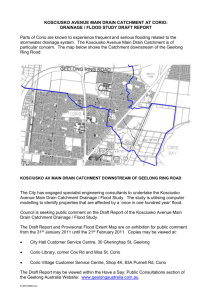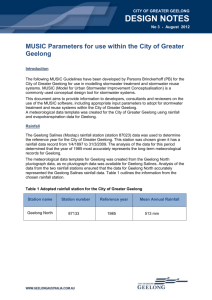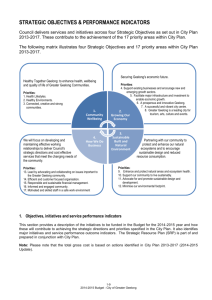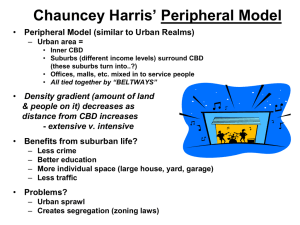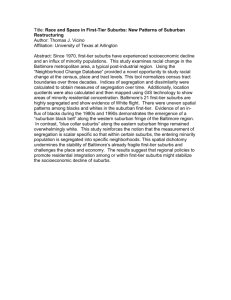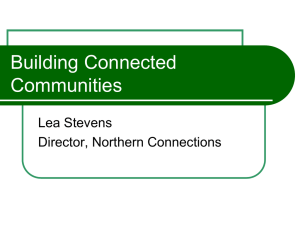Geelong
advertisement
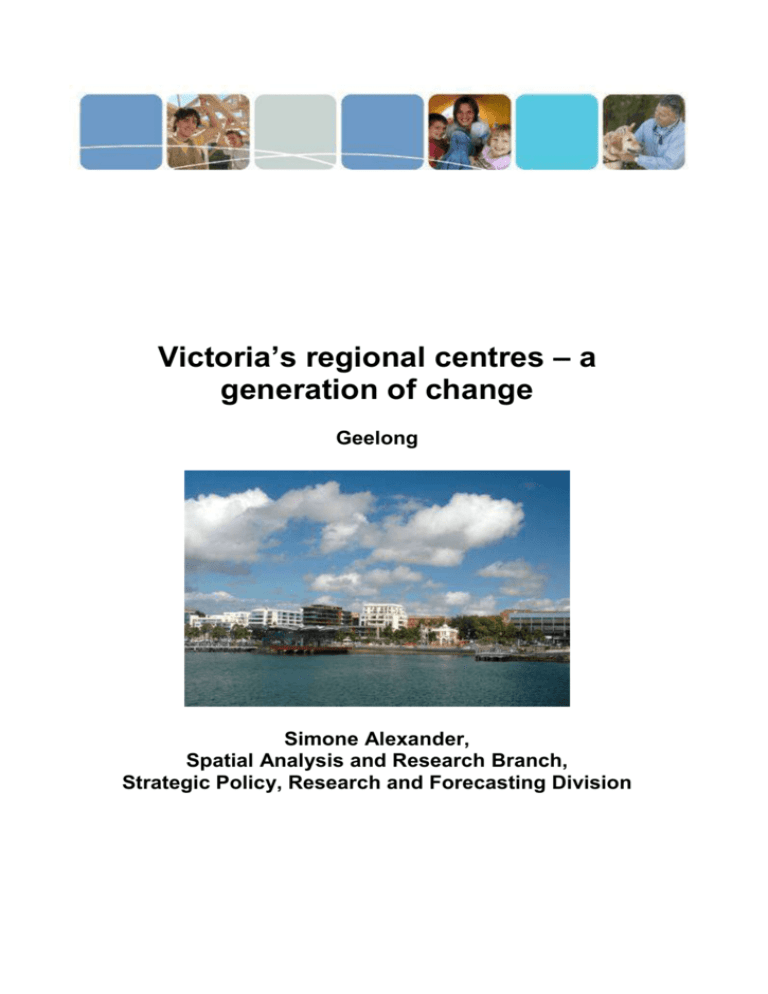
Victoria’s regional centres – a generation of change Geelong Simone Alexander, Spatial Analysis and Research Branch, Strategic Policy, Research and Forecasting Division Date completed (April 2010) Geelong With an urban population of some 136,500 persons, Geelong is not only the largest regional centre in Victoria, but one of the largest in Australia. As the crow flies, it is located about 55 kilometres south west of Melbourne on Corio Bay. Its initial settlement in the 1830s reflected the need for a port to export agricultural produce, particularly from western Victoria, to global markets. In the twentieth century the manufacturing sector began to expand rapidly with several large companies establishing a presence in the city. In more recent decades the dominance of the manufacturing sector has declined, with services becoming more prominent in fuelling economic and population growth. The decline in manufacturing employment, coupled with the exposure to global markets and competition, has resulted in distinct spatial patterns of socio-economic change within Geelong. An important distinguishing feature of suburban development between the large regional centres and in Melbourne is the different time scales at which this occurs. In Melbourne, it is common for suburbs to become established within a short space of time due to the volume of growth. As such, the development of a suburb can often be ascribed to a particular era. This is not necessarily the case in the large regional centres, where suburbs can develop over many decades and therefore incorporate cycles of growth and decline in the same area. Examples of these suburbs include Belmont in Geelong, Mount Helen in Ballarat, and Kangaroo Flat in Bendigo. This report refers to the urban area of Geelong and its suburbs, as opposed to the municipality of Greater Geelong or the wider region that strategies such as the G21 address. In Towns in Time, the Collection Districts (CDs) defined in the Census of Population and Housing form the basis for the definition of the Geelong urban area. It is an amalgamation of contiguous CDs that essentially comprise the built up area. It therefore excludes separate towns such as Ocean Grove or Drysdale. Suburbs are also formed by an amalgamation of CDs. A map showing the suburbs of Geelong is included in Appendix 1. 1. Population change Geelong recorded a population of 126,800 in 1981, rising to 136,520 in 2006 (Table 1). During the recession of the early 1990s, Geelong was particularly hard hit, both by job losses and structural change in the manufacturing sector, as well as the collapse of the Pyramid Building Society and its flow on effects. Between 1991 and 1996, Geelong’s population declined from 129,980 to 128,310, representing a decline of 0.3% per annum. However, in the last ten years, this trend has reversed and the population has grown more rapidly than at any time over the last twenty five years. Between 1996 and 2001, the annual average population growth rate was 0.5% and this increased to 0.8% between 2001 and 2006. Though this was still below the Victorian average, numerically this represented growth of 8,210 persons over the ten years. 1 Table 1: Population change, Geelong, 1981-2006 One of the more notable features about population change in Geelong is that despite the overall population growth, a large number of suburbs lost population both over the period 1981-2006, and over the most recent intercensal period 2001-2006 (Figure 1). Of the 23 suburbs in Geelong, 13 had lower populations in 2006 than they did in 1981, and the equivalent figure in 2001-06 was 11. Population loss was most significant in Norlane, an industrial suburb north of the CBD. In 1981, the population was 10,860, decreasing to 8,170 in 2006, a loss of almost 25%. This is due to a combination of factors, including the impact of manufacturing job losses during the early 1990s recession, as well as ageing of the population and out migration. The neighbouring suburb of Corio also lost significant population, as did the established suburb of Belmont in the south. Geelong’s suburbs form a mosaic across the southern shoreline of Corio Bay. 2 Figure 1: Population change, Geelong suburbs, 1981-2006 Because Geelong’s population increased over the twenty five years, this suggests that the growth that did occur was concentrated in a few areas and was quite strong. Figures 1 and 2 show that areas of growth were concentrated in the southern part of Geelong, particularly the suburbs of Grovedale, Highton and St Albans Park. This is to be expected given that these areas were relatively undeveloped in the early 1980s but are now established, and still growing, parts of Geelong’s urban fabric. Grovedale’s population doubled between 1981 and 2006 and showed consistent growth in each intercensal period. Even in the period 1991-96, when Geelong’s total population decreased, Grovedale recorded an average annual growth rate of 1.1%, which was above the Victorian average. The population of St Albans Park almost trebled between 1981 and 2006, responding to land development opportunities and in-migration of family households. In the last intercensal period (2001-2006) it was still growing strongly at around 4.4% per annum, second behind the rapidly developing suburb of Waurn Ponds. 3 Figure 2: Population change, Geelong suburbs, 2001-2006 Of particular note in the period 2001-2006 has been the slight increase in the population of Geelong’s inner core (the suburbs of Geelong, East Geelong and Thomson), after years of steady loss. This was accompanied by slight increases in the number of dwellings, indicating that some residential redevelopment activity is occurring. In fact, several large apartment blocks have been constructed in central Geelong, particularly along the waterfront. Furthermore, there are several projects either under construction or in the pipeline. The largest of these is the Rippleside Quay development, consisting of 176 apartments on the former Rippleside Ship Repair site in North Geelong (City of Greater Geelong, 2009). Continued redevelopment of central Geelong raises the possibility that the area will record further population increases. Currently, the 2006 suburb populations, despite the turnaround, are still lower than they were throughout the 1980s. This turnaround is similar to the process that has been occurring in inner Melbourne since the mid 1990s, albeit at a smaller scale. 4 2. Age structure Changes in the age structure are important because a significant amount of service provision is age dependent. In Geelong, the major change in the age structure between 1981 and 2006 was a decline in the size of the age cohorts under 35 years, both numerically and proportionally. This was especially the case for 5-17 year olds, ie the school aged population. As a proportion of the population, they declined from 24% in 1981 to 17% in 2006. In numerical terms, this represented a decline of 23%, from 30,370 persons in 1981, to 23,320 in 2006. This has clear ramifications for the provision of education services and there have been some schools closures and mergers in Geelong over the twenty five years.. Similarly, the change in the population aged 75 years and over was significant. Comprising 4% of the population in 1981, this increased to 8% in 2006. In numerical terms, the size almost trebled, from 4,570 persons in 1981, to 11,450 in 2006. Figure 3: Age structure of Geelong, 1981 and 2006 5 In 1981, Geelong had a relatively youthful age structure, with most suburbs containing small proportions of elderly persons (Figure 4). The entire ring of outer suburbs had youthful populations, with less than 4% of elderly persons, while the more established suburbs around the CBD had higher proportions. Bell Park and Geelong (suburb) had the highest proportions of elderly persons at 9%. Figure 4: Proportion of persons aged 75 years and over, Geelong suburbs, 1981 and 2006 By 2006 the ageing of the population was evident with all suburbs recording an increase in the proportion of elderly persons, with the exception of Bell Park and East Geelong. In general, the more established suburbs recorded the largest increases in elderly persons. The largest increase was in North Geelong, which went from 5% to 19%, ie about one in twenty persons to about one in five. Part of this increase was due to the opening of a large nursing home in the suburb. Recently settled areas such as Lovely Banks and Wandana Heights had very few elderly persons in both 1981 and 2006. This is partly because of their smaller populations, but it is also a pattern typical of newer suburban areas which tend to comprise a greater proportion of family households. 6 3. Labour force Regional centres are key providers of employment and services, not only for their own residents, but for increasingly wide rural catchments. Overall, the key industries in regional centres are retail, education, health and manufacturing. Industries such as construction, public administration and transport and storage also have important roles, especially compared to small towns. Figures 5 and 6 show the main features of the resident workforce in Geelong over the period 1986-2006. The resident workforce is the number of employed persons who live in Geelong. This means it includes people who may work elsewhere, but excludes people who live outside of Geelong but who work in the town. The municipality of Greater Geelong has a labour force self containment rate of 75%, which means that three-quarters of people live and work in the town. Clearly, over this time period there have been significant changes in the composition of the workforce. There has been a sharp decline in the proportion of persons employed in manufacturing over the period 1986-2006, from 27% to 15%. In numerical terms, the decline was almost one-third, from 12,920 to 8,790. These changes in the manufacturing sector occurred as a response to global competition and while they were not confined to Geelong, the town was more exposed to these influences due to the nature of manufacturing undertaken (consumer goods such as cars) and the heavy reliance on the sector for employment. Several large manufacturers downsized or abandoned their Geelong operations, particularly in the 1990s. However, despite this large decline, manufacturing is still the largest employer in Geelong and its contribution to economic output is around 41% of the total (City of Greater Geelong, 2009). Figure 5: Proportion of employed persons, by selected industry, Geelong, 1986-2006 7 Figure 6: Number of employed persons, by selected industry, Geelong, 19862006 At the same time, growth in other industries has been fairly evenly spread, though it has largely been in service related industries. The number of people employed in Health Care and Social Assistance doubled over the twenty years, and in terms of the proportion of employed persons increased from 7% to 12%. Barwon Health is one of the largest employers in the Geelong region and the amount of aged care accommodation has increased significantly in response to the ageing population. Although coming off a lower base, employment in accommodation and food services also showed strong growth, increasing from 3% of the workforce in 1986 to 7% in 2006. However, in numerical terms, the increase was more than three-fold, from 1,230 to 3,940. This reflects growth in the domestic tourism market and restaurant sector as well as the changing lifestyles. The transformation of Geelong’s waterfront and the transition to a post-industrial economy is exemplified by the refurbishment of the former Dennys Lascelles woolstore. The building is now part of Deakin University’s waterfront campus, with activities devoted to research and development in the health sector rather than its traditional function of wool storage and export. 8 3.1 Labour force - manufacturing Changes in the manufacturing sector have been felt strongly in Geelong primarily due to its economic reliance on the sector and the nature of the manufacturing work undertaken. As noted above, more than one quarter of Geelong’s workforce was employed in this sector in 1986, dropping to 15% by 2006. When data is examined for suburbs, this shift in the workforce has had profound impacts on the socio-economic structure of the town, with distinct spatial outcomes. Figure 7 below shows the proportion of the residential workforce employed in manufacturing in Geelong’s suburbs in 1986 and 2006. Figure 7: Proportion of persons employed in manufacturing, Geelong suburbs – 1986 and 2006 The dominance of the manufacturing sector in 1986 is clear. The majority of suburbs had more than 20% of their workforce employed in this sector. The highest proportions were recorded in Norlane (44%) and Bell Park (42%), both located in Geelong’s northern suburbs. It is likely that many of these workers would have been employed with manufacturers located in the region – suburbs such as Corio and Norlane were developed in the 1950s specifically to house workers in the then growing manufacturing industry. By 2006 the situation had changed dramatically. The decline in manufacturing employment was very apparent with only six suburbs recording a proportion of 20% or more, compared to 18 in 1986. These were confined to the traditional working class suburbs on the northern fringe and in the south east. Norlane was still the suburb with the highest proportion of 9 manufacturing employed persons (25%), followed by the neighbouring suburb of Corio (23%). Overall however, the majority of Geelong’s suburbs had moved away from a manufacturing working base. During this period, several large manufacturers withdrew or downsized their Geelong operations, while others moved to more capital intensive modes of production. Examples include the cessation of operations of Portland Cement, the shift in focus of the Ford Motor Company from production to research, and the downsizing and eventual closure of Pilkington Glass. Furthermore, the operation of these firms can be interdependent, so that major shifts can have unintended effects elsewhere. An example of this is the decision by the Ford Motor Company to source glass for its cars offshore, rather than from Pilkington Glass, the local supplier. The resulting decline in demand for its products impacted on employment at Pilkington, culminating in its closure in mid 2009 (Begg, 2009). The rapid change in Geelong’s economic base has had profound impacts, resulting in high unemployment and social disadvantage in specific locations. In terms of numbers of persons employed, there were four suburbs where the decline over the twenty years was at least 50% - Norlane, Thomson, Newcomb and Bell Post Hill. In other words, the number of persons employed in manufacturing in these suburbs in 2006 was less than half of the 1986 figure. These major shifts in the employment base have impacts on the social fabric and this is evident in higher levels of unemployment. For example, Norlane had an unemployment rate of 17.3% in 2006, compared to the Geelong average of 7.1%. Despite these changes, Geelong is still recognised as a manufacturing centre and as an industry it is the larger employer in the town. However the nature of production has shifted to more capital intensive modes of production and the jobs that exist require higher skill levels than in the past. The growth of the aerospace industry at Avalon Airport, and the increasing focus of the Ford Motor Company on research and development activities exemplify this trend. 10


